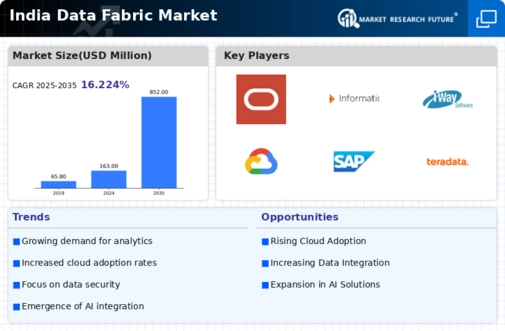Expansion of IoT Ecosystem
The proliferation of Internet of Things (IoT) devices in India is significantly influencing the data fabric market. As more devices become interconnected, the volume of data generated is escalating rapidly, necessitating robust data management solutions. The data fabric market is poised to benefit from this expansion, as organizations require efficient frameworks to integrate and manage the vast amounts of data produced by IoT devices. It is estimated that the number of IoT devices in India will reach over 1 billion by 2025, creating a substantial demand for data fabric solutions that can seamlessly connect and process this data. This trend indicates a growing recognition of the importance of data fabric technologies in managing complex data environments, thereby driving market growth.
Increased Focus on Data Governance
In the context of the the data fabric market, there is a heightened emphasis on data governance and management practices. Organizations are increasingly aware of the need to ensure data quality, compliance, and security, particularly in light of stringent regulations. This focus on governance is driving the adoption of data fabric solutions that facilitate better data management and oversight. According to industry reports, approximately 70% of organizations in India are prioritizing data governance initiatives, which is likely to propel the demand for data fabric technologies. By implementing effective governance frameworks, businesses can enhance their data integrity and compliance, thereby fostering trust and reliability in their data-driven initiatives.
Emergence of Hybrid Cloud Strategies
The shift towards hybrid cloud strategies is emerging as a significant driver for the the data fabric market. Organizations are increasingly adopting hybrid cloud environments to balance the benefits of public and private cloud infrastructures. This trend necessitates the implementation of data fabric solutions that can seamlessly integrate data across various environments, ensuring consistency and accessibility. As per recent forecasts, the hybrid cloud market in India is projected to grow at a CAGR of 30% over the next few years. This growth is likely to stimulate demand for data fabric technologies that facilitate efficient data management and integration across hybrid cloud architectures, thereby enhancing operational agility and flexibility.
Rising Demand for Real-Time Data Processing
The the data fabric market is experiencing a notable surge in demand for real-time data processing capabilities. Organizations are increasingly recognizing the necessity of accessing and analyzing data instantaneously to make informed decisions. This trend is particularly evident in sectors such as finance and e-commerce, where timely insights can significantly impact operational efficiency and customer satisfaction. According to recent estimates, the market for real-time data processing solutions is projected to grow at a CAGR of approximately 25% over the next five years. This growth is likely to drive investments in data fabric technologies, as businesses seek to enhance their data management strategies and improve responsiveness to market changes. Consequently, the rising demand for real-time data processing is a critical driver for the the data fabric market.
Growth of Analytics and Business Intelligence
The the data fabric market is being propelled by the growing adoption of analytics and business intelligence (BI) tools. As organizations strive to leverage data for strategic decision-making, the need for integrated data management solutions becomes increasingly apparent. Data fabric technologies enable seamless access to diverse data sources, facilitating comprehensive analytics and BI capabilities. Recent studies suggest that the analytics market in India is expected to reach $16 billion by 2025, indicating a robust demand for data fabric solutions that support advanced analytics. This growth reflects a broader trend towards data-driven decision-making, positioning the data fabric market as a vital component in the analytics ecosystem.
























Leave a Comment